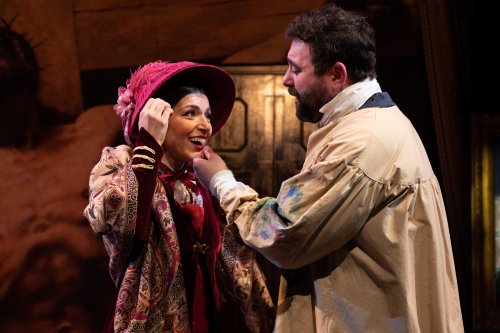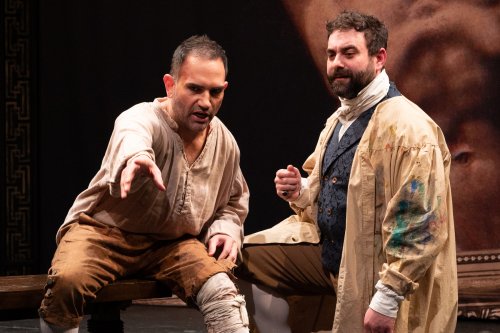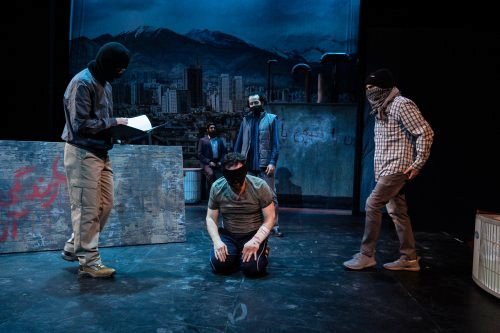Tosca (Heartbeat Opera)
Heartbeat Opera strikes operatic gold by updating one of Puccini’s most beloved stories to modern day Teheran, proving the power of art as it triumphs over oppression.

Anush Avetisyan and Chad Kranak in a scene from Heartbeat Opera’s production of “Tosca” at Baruch Performing Arts Center (Photo credit: Russ Rowland)
[avatar user=”Tony Marinelli” size=”96″ align=”left”] Tony Marinelli, Critic[/avatar]
Just when you think you’ve seen an opera so many times you can’t imagine it being told anew along comes Heartbeat Opera with a riveting take on Puccini’s Tosca. As co-adapted by director Shadi G. and Jacob Ashworth, it is set as a thriller in Teheran, Iran with a cast of singers trying to get through a performance in defiance of the censors.
The opera Tosca has always been set under a dictatorship of an authoritarian regime. It is usually set 1800 with the Kingdom of Naples’s control of Rome threatened by Napoleon’s invasion of Italy. The Heartbeat production underlines the usual terror with Irani police officers in shadows, hidden in stairwells and behind stage entrances ready to arrest the performers if they do anything outside the strict code of ethics and behavior in the Irani culture. This added layer to the story provides a lot of exciting running exits into the audience to avoid capture by the authorities.
Opening projections for the performance explain that the evening’s “actors” have been given permission by the Ministry of Culture to perform Tosca only under the following conditions: (1) all female performers and any images of women used in the production must have their hair covered at all times, according to the law, (2) men and women must behave together according to the morality laws, (3) women may not sing or dance alone in public, according to the law and (4) a religious authority may not be killed by a woman on stage. If any conditions are violated, Security Forces will shut down the performance at intermission. Well, too bad! They are doing it anyway.

Anush Avetisyan and Gustavo Feulien in a scene from Heartbeat Opera’s production of “Tosca” at Baruch Performing Arts Center (Photo credit: Russ Rowland)
The central character of Baron Scarpia, the chief of police, allows his religious fervor to mask the fact he is a sadistic letch. The celebrated singer and actress Floria Tosca is one of his intended victims. Tosca’s lover, the painter Mario Cavaradossi, is a revolutionary sympathizer for the previous government and will be hanged if Tosca does not give in to Scarpia’s evil sexual intentions. The first character we encounter is Cesare Angelotti, an escaped political prisoner, as he takes refuge in the church of Sant’Andrea della Valle, looking for a secret hiding place in the family chapel of his sister, the Marchesa Attavanti. The Marchesa has been going there to pray, and to stash away women’s clothing for her brother to disguise himself in order to further his escape. Unbeknownst to the Marchesa, Cavaradossi has been using her as the subject of his current commission, a painting of Mary Magdalene. Here we have an obvious taunting of the authorities with the Magdalene in the painting minus her hijab with her long hair blowing in the wind.
The violations of code continue through every scene and can’t get stopped as the performers perform the three acts without break, even aiding the stagehands in order to not have a break in action. The final tableau usually has Tosca jump off the parapets of the Castel Sant’Angelo to her death rather than be taken prisoner by Scarpia’s guards. Heartbeat Opera has her climb to the top of the wall, whip off her hijab and wave it in the wind in utter defiance of a culture that demeans women.
Director Shadi G. keeps the action to a quicksilver pace, such that one barely notices the omission of the tenor’s first act aria, “Recondita armonia,” but that aria blatantly compares the beauty of the Marchesa’s and Tosca’s long tresses and eyes, so clearly it wouldn’t play a part in the oppressive Irani culture. Another famous moment is also gone – the offstage shepherd boy solo from the top of Act III, “Io de’ sospiri,” but it is replaced by a former political prisoner/poet smoking on a roof singing the same lyrics of the aria, though in Farsi. Traditionally that ending of the opera provides the vista of Rome from the roof of the Castel Sant’Angelo, but here we find ourselves very clearly in modern-day Tehran.

Joe Lodato and Chad Kranak in a scene from Heartbeat Opera’s production of “Tosca” at Baruch Performing Arts Center (Photo credit: Russ Rowland)
Anush Avetisyan is a stunning Tosca. Her second act aria, “Vissi d’arte,” sung from the floor up against a wall with projections indicating a jail cell of her own, is absolutely penetrating. Her scenes in Act I and Act III with Chad Kranak as Cavaradossi are sublime. Kranak’s lyric tenor is powerful in the Act II “Vittoria, Vittoria,” which is surprising when one considers how he endures more than the usual amount of stage combat than most Cavaradossis are subjected to. His “E lucevan le stelle” in Act III is transcendent, really making us wish we could have heard his “Recondita armonia.”
Gustavo Feulien’s Scarpia is a force to reckon with. His is a lyric baritone that has a luscious timbre reminiscent of the great José van Dam and the handsome bearing and stage presence of the late Dmitri Hvorostovsky. It would be a treat to see him tackle roles like Don Giovanni or Eugene Onegin. Joseph Lodato is convincing as the escapee Angelotti and is later quite mournful as the poet on a Tehran roof. Christopher Nazarian is a perfect bumbling Sacristan and the personification of evil as the guard Spoletta. Reza Mirjalili is a devious Sciarrone and joins Masih Rahmati as the ever-present evil police.
Daniel Schlosberg’s arrangements for Tosca are nothing less than ingenious. He somehow manages to do justice to Puccini’s score with only three cellos, a bass, a flute, a horn, a trumpet and a piano. The bass player doubles on the kamancheh (an Iranian bowed string instrument) to firmly place us in the heart of Iran in the poet’s solo. Conductor Jacob Ashworth revels in the romantic score, providing great support to the soloists and drawing out consistently beautiful playing from his eight musicians.

Christopher Nazarian, Masih Rahmati, Reza Mirjalili, Chad Kranak and Joe Lodato in a scene from Heartbeat Opera’s production of “Tosca” at Baruch Performing Arts Center (Photo credit: Russ Rowland)
Reid Thompson’s scenic design is a triumph – the chapel and the rest of the church interior with the painting drop of Christ on the cross is vivid. No expense was spared for the furniture and dinner setting in Scarpia’s quarters in the Palazzo Farnese and the roof for the firing squad scene somehow seemed more spacious than it was. It was startling to watch Ms. Avetisyan singlehandedly destroy the second act scene to make room for the roof. Oliver Wason’s lighting design was sensitive to the space and how much actually happens under cover of shadows.
Mika Eubanks’ costumes were quite inventive throughout, particularly with regard to the downplay of femininity for Tosca in the second act. Her outfit brought to mind a Mrs. Peel catsuit from The Avengers, with the addition of the hijab and what looked like a slightly bejeweled waist-length black cape. Michael Costagliola’s sound design was attuned to the natural acoustics of the room. The addition of a recorded men’s chorus played loudly through the sound system was a savvy solution to the lack of a full stage chorus for the first act “Te Deum” as sung by Mr. Feulien.
Heartbeat Opera is presenting this Tosca in repertory with Lady M, an adaptation of Verdi’s Macbeth, through this Sunday only. See one or see both; these performances are both revelatory undertakings of two important fixtures of the operatic repertory. For “grand opera,” Heartbeat’s productions are pretty grand.
Tosca (through April 23, 2023)
Heartbeat Opera
Baruch Performing Arts Center, 55 Lexington Avenue, in Manhattan
For tickets, visit http://www.ci.ovationtix.com
Running time: 100 minutes without intermission






Leave a comment